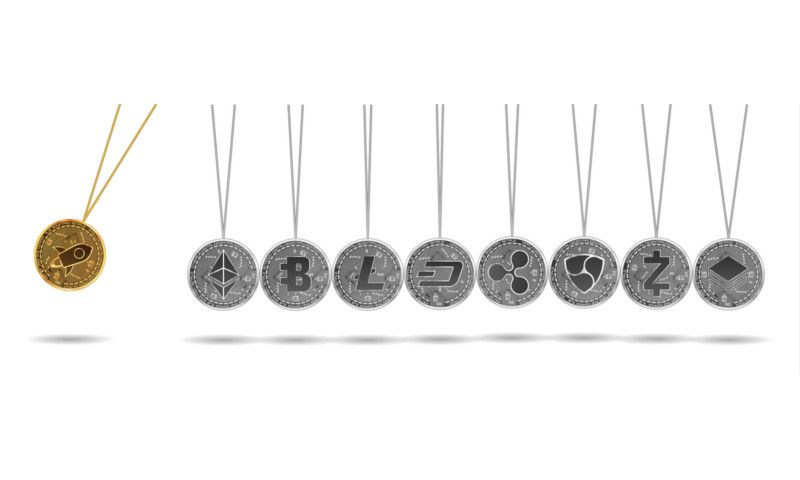
While Bitcoin was the first crypto asset to popularize the concept of “alternative” currencies, there are now a plethora of other cryptocoins to choose from. Stellar lumens (XLM) and Ripple (XRP) are two of the biggest and most popular bitcoin alternatives. As of this writing, Ripple has a market cap of roughly $32.5 billion dollars, while Stellar has a total of $7.5 billion. In terms of market cap, both rank in the top ten. Clearly, Stellar Lumens and Ripple are a “big” deal.
So what makes Ripple and Stellar so popular? How are these coins similar? How are they different? Let’s start by explaining Ripple and Stellar, and examining what have in common. Both were founded by Jed McCaleb and were set up as payment processing systems that utilize the underlying coins. As such, they both aim to make it easier and cheaper to send and process payments.
Given that trillions of dollars worth of payments are processed every day, it’s easy to understand why Ripple and Stellar are so popular. The market is huge and vast sums are spent processing payments. If either or both currencies can reduce processing costs, they could become immensely valuable to the global economy.
Ripple and Stellar were created with related but divergent aims
Both Ripple and Stellar use the Consensus Protocol, which is a rather radical take on consensus algorithms. More or less, the Consensus Protocol uses a system of trusted servers that will coordinate with each other to confirm assets and transactions. So if someone wants to send a payment, the servers will first verify that you have the necessary assets. Once a majority of servers agree, the assets are sent and the transaction is recorded.
However, beyond these broad strokes, Ripple and Stellar diverge dramatically. That divergence started after McCaleb left the Ripple team to found Stellar. It seems that McCaleb’s choice was spurred primarily by vision, and more specifically, altruism. Ripple facilitates payments for banks and financial institutions, utilizing a mix of open source code and closed enterprise software, and is a for-profit business.
Stellar, on the other hand, was set up to address poverty and specifically to assist “unbankable” people, or those who lack access to traditional financing institutions. Stellar is managed by the non profit “Stellar Development Foundation”, and utilizes open source code.
Understanding What Makes Ripple and Stellar Similar and Different
Clearly, such divergent visions could result in very different cryptocurrencies. Initially, Stellar actually shared much of the same code as Ripple, but in 2015, the Stellar Development Foundation released Stellar Core, a complete overhaul of Ripple’s code. Since then, the two cryptocurrencies have grown further apart.
Ripple launched with 100 billion XRP coins, which is every Ripple coin that ever was and ever will be. Unlike bitcoin, Ripple’s money supply does not increase (or decrease), and there is no mining process. Stellar likewise launched with 100 billion coins, but new lumens are added each year with the inflation rate set at 1%.
Ripple has currently partnered with over 100 banks and claims that it can save banks an average of $3.76 per transaction. Given that banks process huge numbers of payments, such savings is certainly nothing to scoff at. Last year, Banco Santander, Swiss bank (UBS), American Express, among others, announced that they were testing Ripple for potential applications.
Stellar, on the other hand, has been forging partnerships with other nonprofits and social enterprises. For example, Stellar has teamed up with Parkway Projects, which focuses on providing banking solutions across Africa. Another partner is Coins.ph, a mobile financial services provider that targets the underbanked in South East Asia.
There’s another important difference between Stellar and Ripple: Stellar is considered to be more open, while Ripple has a lot of concentrated power. Ripple generated controversy when Jed McCaleb left by freezing his Ripple assets. Many considered this an overstep and evidence that Ripple is far from a neutral party.
Ripple claims that it is decentralizing its ledger, however, and has released a strategy for doing so. Ripple and McCaleb eventually settled their differences. Stellar, likewise, has a considerable amount of centralization baked into its system. However, most traders have fretted less over this, owing to the non profit nature of the Stellar Development Foundation.
Choosing Between Stellar Lumens and Ripple
Which currency should financial institutions, businesses, traders, and investors chose? That’s beyond the scope of this article. However, a good place to start is considering your aims and preferences. Are you more comfortable with the business/profit potential of a payment system that targets big banks? If so, Ripple is an attractive choice. Or do you want to make a difference in the lives of the poor? In that case, Stellar offers a ton of upside.
*This is a sponsored article. The views expressed in this article belong to the original author. The reader bears all the responsibility for any actions he or she takes based on the information presented in this article.